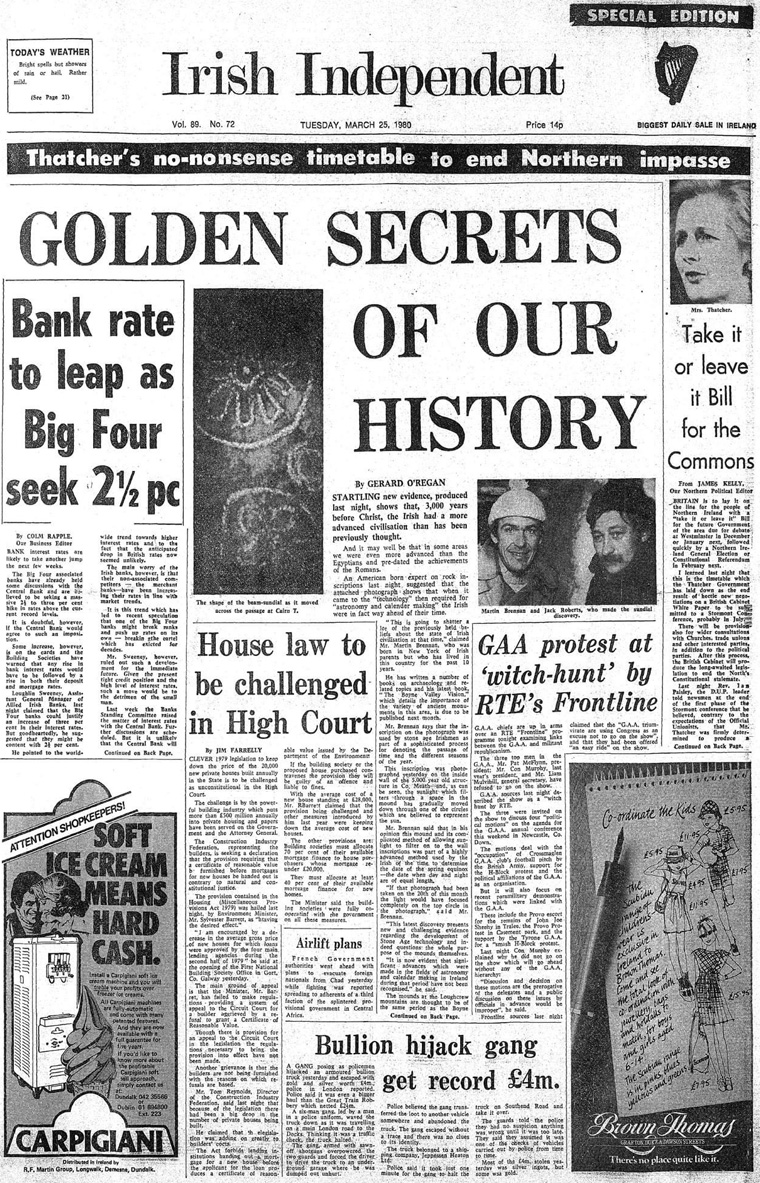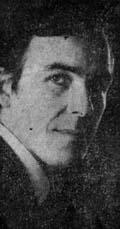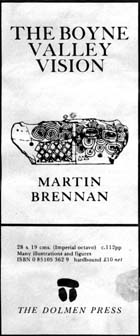
Golden Secrets of our History
By Gerald O'Regan - published in the Irish Independent - March 25, 1980Startling new evidence, produced last night, shows that, 3,000 years before Christ, the Irish had a more advanced civilisation than has been previously thought.
And it may well be that in some areas we were even more advanced than the Egyptians and pre-dated the achievements of the Romans.
An American born expert on rock inscriptions last night suggested that the attached photograph shows that when it came to the "technology" then required for "astronomy and calendar making" the Irish were in fact way ahead of their time.
"This is going to shatter a lot of the previously held beliefs about the state of Irish civilisation at that time," claimed Mr. Martin Brennan, who was born in New York of Irish parents but who has lived in this country for the past 10 years.
He has written a number of books on archaeology and related topics and his latest book, The Boyne Valley Vision which details the importance of the variety of ancient monuments in this area, is due to be published next month.
 Mr. Brennan
says that the inscription on the photograph was used by stone age Irishmen as part of a sophisticated process for denoting the passage of time and the different seasons of the year.
Mr. Brennan
says that the inscription on the photograph was used by stone age Irishmen as part of a sophisticated process for denoting the passage of time and the different seasons of the year.
This inscription was photographed yesterday on the inside wall of the 5,000 year old structure in County Meath and, as can be seen, the sunlight which filters through a space in the mound has gradually moved down through one of the circles which are believed to represent the sun.
Mr. Brennan said that in his opinion this mound and its complicated method of allowing sunlight to filter on to the wall inscriptions was part of a highly advanced method used by the Irish of the time to determine the date of the spring equinox - the date when day and night are of equal length.
"If that photograph had been taken on the 20th of this month the light would have focused completely on the top circle in the photograph." said Mr. Brennan.
"This latest discovery presents new and challenging evidence regarding the development of Stone Age technology and indeed questions: the whole purpose of the mounds themselves. "It is now evident that significant advances which were made in the fields of astronomy and calendar making in Ireland during that period have not been recognised." he said.
 The
mounds at the Loughcrew mountains are thought to be of the same period
as the Boyne Valley mounds about 3,200 and places them in a much earlier period than the Egyptian pyramids," he added.
Mr. Brennan said that the series of mounds in the area could now be seen as operating as a
"gigantic sundial for the year" and suggested that it is "amazing" that after 5,000 years the
structure is still functioning in its original capacity.
The
mounds at the Loughcrew mountains are thought to be of the same period
as the Boyne Valley mounds about 3,200 and places them in a much earlier period than the Egyptian pyramids," he added.
Mr. Brennan said that the series of mounds in the area could now be seen as operating as a
"gigantic sundial for the year" and suggested that it is "amazing" that after 5,000 years the
structure is still functioning in its original capacity.
He pointed out that this obviously required highly developed building skills and that this sophistication was matched by considerable advancement also in the fields of astronomy and calendar making.
"This method for regulating the solar year is the earliest known attempt at calendar making and sundailling," he said.
The precision, skill and imagination required for these constructions is almost unbelievable - this was a seasonal sun dial which went far beyond the needs of a primitive agricultural society.
"It appears that this area of Co. Meath was used by prehistoric Irishmen as a giant astronomical calendar," said Mr. Brennan.
"We could be entering a new era in the bid to understand our roots," he added.
Boyne Valley Private Day Tour
 Immerse yourself in the rich heritage and culture of the Boyne Valley with our full-day private tours.
Visit Newgrange World Heritage site, explore the Hill of Slane, where Saint Patrick famously lit the Paschal fire.
Discover the Hill of Tara, the ancient seat of power for the High Kings of Ireland.
Book Now
Immerse yourself in the rich heritage and culture of the Boyne Valley with our full-day private tours.
Visit Newgrange World Heritage site, explore the Hill of Slane, where Saint Patrick famously lit the Paschal fire.
Discover the Hill of Tara, the ancient seat of power for the High Kings of Ireland.
Book Now
Home
| Visitor Centre
| Tours
| Winter Solstice
| Solstice Lottery
| Images
| Local Area
| News
| Knowth
| Dowth
| Articles
| Art
| Books
| Directions
| Accommodation
| Contact

